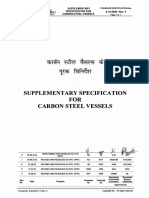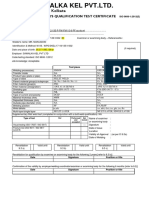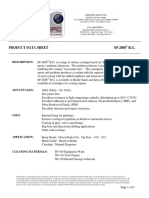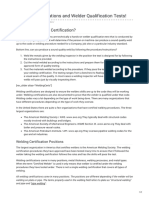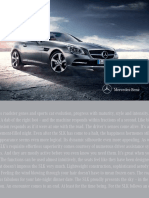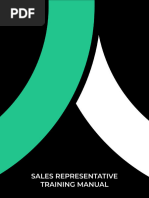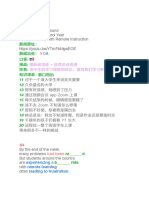Asme Code For Ultrasonic Testing The Knowledge Sinequation: Ashok J. Trivedi
Asme Code For Ultrasonic Testing The Knowledge Sinequation: Ashok J. Trivedi
Uploaded by
Max Celis CCopyright:
Available Formats
Asme Code For Ultrasonic Testing The Knowledge Sinequation: Ashok J. Trivedi
Asme Code For Ultrasonic Testing The Knowledge Sinequation: Ashok J. Trivedi
Uploaded by
Max Celis COriginal Title
Copyright
Available Formats
Share this document
Did you find this document useful?
Is this content inappropriate?
Copyright:
Available Formats
Asme Code For Ultrasonic Testing The Knowledge Sinequation: Ashok J. Trivedi
Asme Code For Ultrasonic Testing The Knowledge Sinequation: Ashok J. Trivedi
Uploaded by
Max Celis CCopyright:
Available Formats
Indian Society for Non-Destructive Testing Hyderabad Chapter
Proc. National Seminar on Non-Destructive Evaluation Dec. 7 - 9, 2006, Hyderabad
ASME CODE FOR ULTRASONIC TESTING THE KNOWLEDGE SINEQUATION
ASHOK J. TRIVEDI
M/s Electronic & Engineering Co. India Pvt. Ltd., Mumbai-400 053, India
e-mail: ashokjtrivedi@vsnl.net Abstract With the globalization stance of government, India is quickly emerging as an important business nation in the world. Many overseas reputed organizations have identified India for their international engineering business operations and have set up their offices as well as manufacturing facilities in recent past. Being techno economically competent many Indian industries have also started exports to the developed countries. Obviously, in this international competitive era, a product stands out amongst others only by its virtue of soundness, reliability and safety. To accomplish this, qualified professionals, calibrated equipments / instruments, standard examination procedures and codified acceptance criteria are the sinequanon, where NDE assumes utmost importance. Amongst various NDE methods available for inspection, this paper highlights ASME Code requirements for ultrasonic examination. It is very essential to prepare a written NDE procedure, get it approved from an authorized person and satisfactorily demonstrate the procedure to an authorized inspector before its actual implementation on the job. Shortcuts to this would result in failure to meet code requirements and unpleasant situation for the product as well as organization. In particular this paper deals with ultrasonic examination of materials and welds as per ASME Section V, which is providing the guide lines for evolution of NDE procedures and presentation of proper NDE reports. Key Words : ASME Code, Sinequanon, Raw Materials, Welds, NDE Procedures, NDE Reports. Introduction : For any organization to sell a product in this international competitive era, the product must have the required quality, reliability, soundness as well as safety. To achieve these parameters the product must meet various international test specifications and code requirements. NDE plays a very important role in achieving the above parameters. For successful implementation of nondestructive examinations proper NDE procedures are very essential. This paper deals with following two aspects as per ASME Code : (A) Procedure for ultrasonic examination of materials. (B) Procedure for ultrasonic examination of welds. The paper highlights about the essential as well as non-essential variables in preparing NDE procedures as well as essential requirements to be fulfilled while preparing NDE reports for both the above aspects at (A) and (B) as per ASME Section V Code requirements. (A) Guide Lines for Preparing Written Procedure For Ultrasonic Examination Of Materials :
ASHOK J. TRIVEDI ASME Sec. V Article 5 gives the guide lines for ultrasonic examination of various materials. It also refers to Article 23 of the same section. It also suggests to consult referencing Code Section for specific requirements. This Code requires that ultrasonic examination shall be performed in accordance with a written procedure. It specifies the minimum requirements of a written NDE procedure, requirements of a procedure qualification, essential as well as non-essential variable of a written NDE procedure, requirements of nondestructive examination report. Variables of an ultrasonic examination procedure are tabulated on Page 4. To cover the above aspects and to give one illustration the author suggests following format for a written ultrasonic examination procedure of plates : Procedure No. Rev. No. and Date. Scope. Reference Documents. Surface Condition of Materials. Heat Treatment. Equipment : Principle on which equipment function, Equipment Make and Model, Frequency Range, dB control settings available, Screen Height Linearity, Amplitude Control Linearity, Sweep Range Calibration Check, Etc. 7. Transducers : Type, Frequency, Size, Angle if type selected is angle beam transducer, Wave Mode, Any Special Search Unit. 8. Couplant : Brand and Type. 9. Responsibilities and Operators Qualification. 10. Range Calibration of Instrument. 11. Sensitivity Calibrations and Calibration Checks. 12. Scanning and Sizing a Flaw, Scan Over Lap, Scanning Speed, Etc. 13. Acceptance / Rejection Criteria. 14. Report : Shown on Page 3. 15. Table showing essential as well as non-essential variables for the procedure. 16. Clause for Demonstration of the procedure to the satisfaction of AI. 17. Name, Qualification Level and Signature of person preparing the procedure. 18. Name Qualification Level and Signature of person approving the procedure. 1. 2. 3. 4. 5. 6.
UT REPORT FORMAT-1 Procedure No. Date Report No. Job No. Reference/Identification Test date Test Material Surface Condition Object Test Equipment UFD Instrument : Make : Test Probe Couplant Test Range Calibration Start Time Time Base Sensitivity (Echo Amplitude as % FSH) Gain Observations/ Remarks: Finish Time Normal Beam Frequency Size
Date :
Model: TR Probe Frequency Size
dB
dB
Name of Operator Qualification Level II Signature
Inspection Authority
Date
Signature
Date
ASHOK J. TRIVEDI TABLE T-522 of ASME Section V, Article-5 VARIABLES OF AN ULTRASONIC EXAMINATION PROCEDURE Sr. No. Requirement Essential Variable Procedure Nonessential Reference Variable Para No.
Material types and configurations to be examined, including thickness, dimensions 1. X and product from (castings, forgings, plate, etc.) 2. Personnel qualification requirements X Personnel performance requirements, when 3. X required The surface/s from which the examination X 4. shall be performed Surface condition (examination surface, X 5. calibration block) 6. Couplant : Brand name or type X Technique(s) (straight beam, angle beam, X 7. contact, and /or immersion) Angle(s) and mode(s) of wave propagation in X 8. the material. Search unit type(s), frequency(ies), element X 9. size(s)/shapes(s) Special search units, wedges, shoes, or X 10. saddles, when used. 11. Ultrasonic instrument(s) X Calibration [(calibration block(s) and X 12. technique(s)] 13. Direction and extent of scanning X Automatic alarm and/or recording 14. X equipment, when applicable. 15. Scanning (manual vs. automatic) X 16. Method for sizing indications X Computer enhanced data acquisition, when X 17. used Records, including minimum calibration data X 18. to be recorded (e.g. instrument settings) 19. Scan overlap (decrease only) X Note : 1. A revised procedure shall be prepared and approved by Level III for any change in essential or non-essential variable/s. 2. Whenever any change is made in any of the essential variable/s, re demonstration of the procedure to the satisfaction AI shall be done. 3. When ever any change is made in any of the non-essential variable/s redemonstration of procedure to AI is not required.
(B) Guide Lines For Preparing Written Procedure For Ultrasonic Examination Of Welds : ASME Sec. V Article 4 gives the guide lines for ultrasonic examination of various materials. It also suggests to consult referencing Code Section for specific requirements. This Code requires that ultrasonic examination shall be performed in accordance with a written procedure. It specifies the minimum requirements of a written NDE procedure, requirements of a procedure qualification, essential as well as non-essential variable of a written NDE procedure, requirements of nondestructive examination report. Variables of an ultrasonic examination procedure are tabulated on Page 7. To cover the above aspects and to give one illustration the author suggests following format for a written ultrasonic examination procedure of welds : 1. 2. 3. 4. 5. 6. 7. Procedure No. Rev. No. and Date. Scope. Reference Documents. Configuration. Examination Surface. Surface Condition of Materials. Equipment : Principle on which equipment function, Equipment Make and Model, Frequency Range, dB control settings available, Screen Height Linearity, Amplitude Control Linearity, Sweep Range Calibration Check, Etc. 8. Transducers : Type, Frequency, Size, Angle, Wave Mode, Any Special Search Unit. 9. Couplant : Brand and Type. 10. Responsibilities and Operators Qualification. 11. Range Calibration of Instrument. 12. Sensitivity Calibrations, Reference Standard Calibration Blocks, Calibration Check of Instrument, Gain Corrections. 13. Scanning and Establishment of a discontinuity, Sizing a Flaw, Scan Over Lap, Scanning Speed, Etc. 14. Acceptance / Rejection Criteria. 15. Report : Report No. and Date, Procedure No. Rev. No. Date, Equipment : Make, Model, Sr. No., Search Unit : Type, Size, Frequency, Angle, Wave Mode, Search Unit Cable : Type and Length, Special Search Unit if used, Couplant : Brand and Type, Identification of Calibration Block, Reference Reflector, Reference Level Gain, Scanning Sensitivity, Damping and Reject Settings if used, Identification and Location of weld examined, Surface from which examination was conducted and surface condition, Records of un-acceptable as well as recordable indications, record of inaccessible weld areas, Name and qualification Level of Operator, Date of Examination, Reference Code used, Computerized Program if used, Etc. 16. Marking and Repairing, 17. Re-examination. 18. Table showing essential as well as non-essential variables for the procedure. 19. Clause for Demonstration of the procedure to the satisfaction of AI. 20. Name, Qualification Level and Signature of person preparing the procedure. 21. Name Qualification Level and Signature of person approving the procedure. Conclusions : 1. Nondestructive Examination requires preparation and approval of NDE Procedure. 2. It also requires satisfactory demonstration of the procedure to Authorized Inspector.
ASHOK J. TRIVEDI 3. Person preparing and approving NDE procedure must have : (A) Required qualification and experience in NDE. (B) He must have relevant information about the part or component to be examined, its manufacturing process, service condition, type and location of discontinuity expected, method of determining such discontinuities, limitations involved with the applied NDE method and technique. (C) Applicable Code and Standards. 4. NDE requires properly calibrated equipments and properly trained, certified and experienced operators. References : 1. ASME Sec. V : Article 4, Article 5, Article 23 2. SNT-TC-1A of ASNT, BIS Document : 13805 3. ASME Sec. VIII, Div. I, ASME Sec. III.
TABLE T- 421 OF ASME SECTION-V, ARTICLE- 4. REQUIREMENTS OF AN ULTRASONIC EXAMINATION PROCEDURE NonProcedure Essential Sr. Requirement Essential reference Variable No. variable Para No. 1 Weld Configurations to be examined, including thickness dimensions and base X material product form (Pipe, Plate, etc.) 2 The surfaces from which the examination X shall be performed 3 Technique(s) (straight beam, angle beam, X contact, and/or immersion) 4 Angle(s) and mode(s) of wave propagation X in the material. 5 Search Unit type(s), frequency(ies), X element size(s)/shapes(s) 6 Special search units, wedges, shoes or X saddles, when used. 7 Ultrasonic instrument(s) X 8 Calibration (Calibration block(s) and X technique(s)) 9 Directions and extent of scanning X 10 Scanning (manual vs. automatic) X 11 Method for discriminating geometric from X flaw indications. 12 Method for sizing indications X 13 Computer enhanced data acquisition, when X used 14 Scan overlap (decrease only) X 15 Personnel performance requirements, when X required 16 Personnel qualification requirements X 17 Surface condition (examination surface, X calibration block) 18 Couplant: brand name or type X 19 Automatic alarm and/or recording X equipment, when Applicable 20 Records, including minimum calibration data to be recorded (e.g. instrument X settings) Note: 1. A revised procedure shall be prepared and approved by Level III for any change in essential or non-essential variable/s. 2. Whenever any change is made in any of the essential variable/s, re demonstration of the procedure to the satisfaction AI shall be done. 3. When ever any change is made in any of the non-essential variable/s re-demonstration of procedure to AI is not required.
You might also like
- b737 PMDG ManualDocument287 pagesb737 PMDG Manualjjgp100% (3)
- Land Patents & Allodial TitlesDocument12 pagesLand Patents & Allodial TitlesAnonymous100% (8)
- Vefv1100m 5Document1 pageVefv1100m 5Tariq HussainNo ratings yet
- Probable Radiography Interview QuestionsDocument2 pagesProbable Radiography Interview QuestionsSantanu SahaNo ratings yet
- API Standard 653, Tank Inspection, Repair, Alteration, and ReconstructionDocument14 pagesAPI Standard 653, Tank Inspection, Repair, Alteration, and ReconstructionSaqib KhanNo ratings yet
- Fir-001 - 10 03 18Document1 pageFir-001 - 10 03 18Kartik SolankiNo ratings yet
- EC8761-Advanced Communication Lab ManualDocument100 pagesEC8761-Advanced Communication Lab ManualRajkumar kk83% (6)
- Job Structure of AIS GlassDocument59 pagesJob Structure of AIS Glasssimonebandrawala9No ratings yet
- List of Questions EN 13445 - 2014Document11 pagesList of Questions EN 13445 - 2014kamal615No ratings yet
- Digital Leeb Hardness Tester Th270aDocument7 pagesDigital Leeb Hardness Tester Th270aSanjay GhodadraNo ratings yet
- STD-InSP-0007 (Fitting Inspection Report)Document3 pagesSTD-InSP-0007 (Fitting Inspection Report)airbroomNo ratings yet
- 6-12-0002 Rev 8 Supplementary Specification For Carbon Steel VesselsDocument7 pages6-12-0002 Rev 8 Supplementary Specification For Carbon Steel Vesselsravi2007No ratings yet
- En 14096-1 Final DraftDocument11 pagesEn 14096-1 Final Draftrizwankhanzhi100% (1)
- A106 Seamless Carbon Steel Pipe: Hydrostatic TestingDocument7 pagesA106 Seamless Carbon Steel Pipe: Hydrostatic TestingTan Chee MingNo ratings yet
- API 510 Examination Sample ItemsDocument3 pagesAPI 510 Examination Sample ItemsMagira PasaribuNo ratings yet
- Ut ProcedureDocument7 pagesUt Procedurearavindan100% (1)
- Ins-P-021, Long Seam Set UpDocument4 pagesIns-P-021, Long Seam Set UpDeepak100% (1)
- D T LabDocument30 pagesD T LabMahmoud Alwasif100% (1)
- QP STD R 008 NDT Standard Part 4 MPTDocument11 pagesQP STD R 008 NDT Standard Part 4 MPTthmaraishriNo ratings yet
- Procedure For Liquid Penetrant Testing: Omnifab Engineers Pvt. LTDDocument10 pagesProcedure For Liquid Penetrant Testing: Omnifab Engineers Pvt. LTDgayaprasad2310No ratings yet
- PMA A403Gr304L EN 13480Document1 pagePMA A403Gr304L EN 13480CRISTIAN SILVIU IANUCNo ratings yet
- Unit-9 Visual Testing (VT) : 1. ProcedureDocument5 pagesUnit-9 Visual Testing (VT) : 1. ProcedureVivekanandan JNo ratings yet
- B Boehler-Fox-Cel Se en v1Document1 pageB Boehler-Fox-Cel Se en v1tacosanchezbrayanNo ratings yet
- Ut PWPS 001Document1 pageUt PWPS 001Goutam Kumar Deb100% (1)
- Body of Knowledge PDFDocument1 pageBody of Knowledge PDFAda RamirezNo ratings yet
- PMI Positive Material IdentificationDocument2 pagesPMI Positive Material Identificationmahati munnaNo ratings yet
- 0901b80380959cc7 PDFDocument2 pages0901b80380959cc7 PDFBonaventure NzeyimanaNo ratings yet
- Standard Specification For Castings, Iron-Chromium, Iron-Chromium-Nickel, Corrosion Resistant, For General ApplicationDocument8 pagesStandard Specification For Castings, Iron-Chromium, Iron-Chromium-Nickel, Corrosion Resistant, For General ApplicationFayez Al-ahmadiNo ratings yet
- TDC PP742 F2Document3 pagesTDC PP742 F2Arjun PrajapatiNo ratings yet
- Table A3 Typical Storage and Drying Conditions For Covered Arc Welding ElectrodesDocument1 pageTable A3 Typical Storage and Drying Conditions For Covered Arc Welding Electrodesravi00098No ratings yet
- Sa 450/sa 450MDocument13 pagesSa 450/sa 450MSaravana VelNo ratings yet
- Astm A-572Document5 pagesAstm A-572Wanderley CardosoNo ratings yet
- 2-Asme BPVC Section Ix-2013Document2 pages2-Asme BPVC Section Ix-2013Reda ElsawyNo ratings yet
- NoticeDocument1 pageNoticeAnirban Sen SharmaNo ratings yet
- Cswip 3.1Document2 pagesCswip 3.1Anna PariniNo ratings yet
- Magnetic Particle Examination of WeldsDocument4 pagesMagnetic Particle Examination of WeldsshruthiNo ratings yet
- Strip Check - EIL - TQ PDFDocument2 pagesStrip Check - EIL - TQ PDFpl_arunachalam79100% (1)
- Me Interview QuesDocument37 pagesMe Interview QuesLUCIFERBREONo ratings yet
- Qualified Welder List According To Asme IxDocument5 pagesQualified Welder List According To Asme IxAhmad Nabil ElsharkawyNo ratings yet
- Is 7310 RequirementsDocument4 pagesIs 7310 RequirementsRavichandran Tirupattur SubramaniamNo ratings yet
- E290 RT Rev.0Document19 pagesE290 RT Rev.0Amir Reza Rashidfarokhi100% (1)
- Product Data Sheet SP-2888 RGDocument8 pagesProduct Data Sheet SP-2888 RGJR RZNo ratings yet
- Industrial X Ray Sources:: PDF Created With Pdffactory Pro Trial VersionDocument14 pagesIndustrial X Ray Sources:: PDF Created With Pdffactory Pro Trial Versionkinjalpatel12345No ratings yet
- WWW Wollastonalloys Com Materials 2Document8 pagesWWW Wollastonalloys Com Materials 2Mark RomeroNo ratings yet
- Work Instruction FOR: Tensile TestDocument4 pagesWork Instruction FOR: Tensile TestmahendraNo ratings yet
- Is 9902 2004 PDFDocument11 pagesIs 9902 2004 PDFAgniva DuttaNo ratings yet
- Asme Criteria For Welding PreheatingDocument2 pagesAsme Criteria For Welding PreheatingsauloctNo ratings yet
- Procedure Vs InstructionDocument2 pagesProcedure Vs Instructionkendall0609No ratings yet
- ASME P NumbersDocument6 pagesASME P NumbersAbdul KharisNo ratings yet
- ASME P NumbersDocument3 pagesASME P Numbersrajesh100% (1)
- NDE-Penetrant TestDocument2 pagesNDE-Penetrant TestCandy KendeeNo ratings yet
- Zzze) I (ZFRP: QW-163 Acceptance Criteria - Bend Tests QW-163 Acceptance Criteria - Bend TestsDocument1 pageZzze) I (ZFRP: QW-163 Acceptance Criteria - Bend Tests QW-163 Acceptance Criteria - Bend TestsSARSAN NDTNo ratings yet
- NDT of PipingDocument1 pageNDT of PipingVu Tung LinhNo ratings yet
- Welding Certifications and Welder Qualification Tests PDFDocument7 pagesWelding Certifications and Welder Qualification Tests PDFArjun JpNo ratings yet
- Steel Wedge Gate Valves (Flanged and Butt-Welding Ends) For The Petroleum, Petrochemical and Allied IndustriesDocument28 pagesSteel Wedge Gate Valves (Flanged and Butt-Welding Ends) For The Petroleum, Petrochemical and Allied IndustriesImed BenNo ratings yet
- ATTAR Phased Array Visualisation ToolDocument3 pagesATTAR Phased Array Visualisation ToolGOUTHAM RATHINAMNo ratings yet
- ASME UT Procedure WritingDocument7 pagesASME UT Procedure WritingReiaz Hosein100% (3)
- TP 107 PDFDocument7 pagesTP 107 PDFSurendra Kumar ChordiaNo ratings yet
- Asme Code For Ultrasonic Testing The Knowledge Sinequation: Ashok J. TrivediDocument7 pagesAsme Code For Ultrasonic Testing The Knowledge Sinequation: Ashok J. TrivediAli Ben AmorNo ratings yet
- Ultrasonic Testing Level Ii - GuidelinesDocument1 pageUltrasonic Testing Level Ii - Guidelinesbenderman1No ratings yet
- Procedure NDT-PAUT-01Document13 pagesProcedure NDT-PAUT-01Anna ravi100% (1)
- Asme Utf ReportDocument2 pagesAsme Utf ReportMHORN727No ratings yet
- JIMAH East PAUT Procedure Rev 0 14062017 PDFDocument62 pagesJIMAH East PAUT Procedure Rev 0 14062017 PDFRiccoNo ratings yet
- NCRTAS Brochure UpdatedDocument2 pagesNCRTAS Brochure UpdatedPoongodiNo ratings yet
- InstagramDocument3 pagesInstagramAffan RamaNo ratings yet
- SQC Notes 2018 AdminDocument9 pagesSQC Notes 2018 AdminAby MathewNo ratings yet
- Accumulating and Assigning Cost To ProductDocument2 pagesAccumulating and Assigning Cost To ProductAchmad Faizal AzmiNo ratings yet
- 2020-06-18 ADB - Asian Development Outlook 2020 Supplement - Lockdown, Loosening, and Asia's Growth ProspectsDocument12 pages2020-06-18 ADB - Asian Development Outlook 2020 Supplement - Lockdown, Loosening, and Asia's Growth ProspectsMuhammad Fadhly Dzil IkramNo ratings yet
- The Mediation Effect of Job Satisfaction and Organizational Commitment On The Organizational Learning Effect of The Employee PerformanceDocument27 pagesThe Mediation Effect of Job Satisfaction and Organizational Commitment On The Organizational Learning Effect of The Employee PerformanceNely Noer SofwatiNo ratings yet
- Parle Agro PVT LTD.: Acknowledge FormDocument4 pagesParle Agro PVT LTD.: Acknowledge FormPankaj TripathiNo ratings yet
- Operating Instructions BZ 500 LSN / BE 500Document23 pagesOperating Instructions BZ 500 LSN / BE 500ahmed esmailNo ratings yet
- Full Report Case Study 17Document39 pagesFull Report Case Study 17Sheikh Are-kimNo ratings yet
- The New Auditor's Report: Overview of The New and Revised Auditor Reporting Standards and Related Conforming AmendmentsDocument26 pagesThe New Auditor's Report: Overview of The New and Revised Auditor Reporting Standards and Related Conforming AmendmentsAndhika Suhud Meliora SitumorangNo ratings yet
- E Abstract GCGE2017Document99 pagesE Abstract GCGE2017kokong konengNo ratings yet
- Bromo PDFDocument6 pagesBromo PDFMspalato 7No ratings yet
- Eu & me-NA0422312ENNDocument84 pagesEu & me-NA0422312ENNeanahanaNo ratings yet
- Mercedes SLK Class BrochureDocument88 pagesMercedes SLK Class BrochureEzzy Latrell KaprangiNo ratings yet
- 3.2.S.6 (Container Closure Systems)Document3 pages3.2.S.6 (Container Closure Systems)AaminasindhuNo ratings yet
- Shared Responsibility ModelDocument2 pagesShared Responsibility ModelIntissar SalhiNo ratings yet
- Marantz Hifi Av-Receivers SR6003 OverviewDocument31 pagesMarantz Hifi Av-Receivers SR6003 OverviewDumitru DamianNo ratings yet
- Section 3 - Emergency Response Plan - FinalDocument78 pagesSection 3 - Emergency Response Plan - FinalRhem Rick CorpuzNo ratings yet
- Sales Training Manual 2023Document113 pagesSales Training Manual 2023Mia Salcedo100% (1)
- Yao 2009Document25 pagesYao 2009lisa kustinaNo ratings yet
- How Does Steel Corrode in Water?: 2fe 2fe + 4eDocument14 pagesHow Does Steel Corrode in Water?: 2fe 2fe + 4eAlberto Leo SimarmataNo ratings yet
- MG6 L02 Note For StudentsDocument7 pagesMG6 L02 Note For Students洪詩婷No ratings yet
- USP-NF Hydroxyzine HydrochlorideDocument4 pagesUSP-NF Hydroxyzine Hydrochlorideeldridatech pvt ltdNo ratings yet
- Petrel 2020-4 Release NotesDocument19 pagesPetrel 2020-4 Release NotesAiwarikiaarNo ratings yet
- Social Media AbuseDocument28 pagesSocial Media AbuseRingle JobNo ratings yet
- Structure of Ethics ManagementDocument5 pagesStructure of Ethics ManagementIulia T Popa100% (1)











